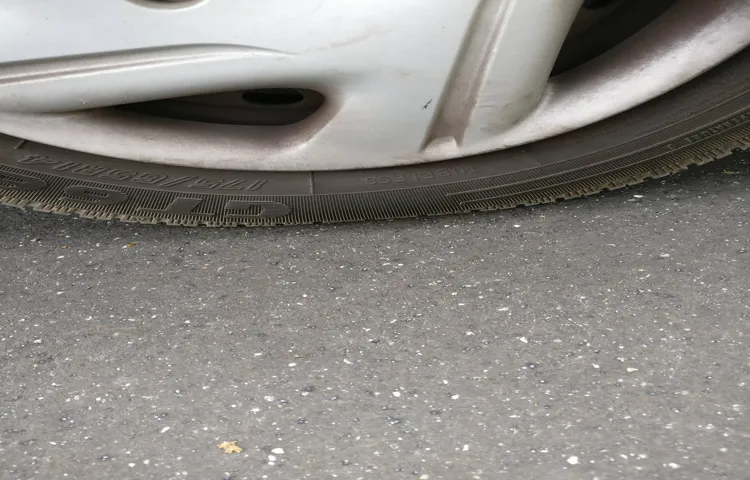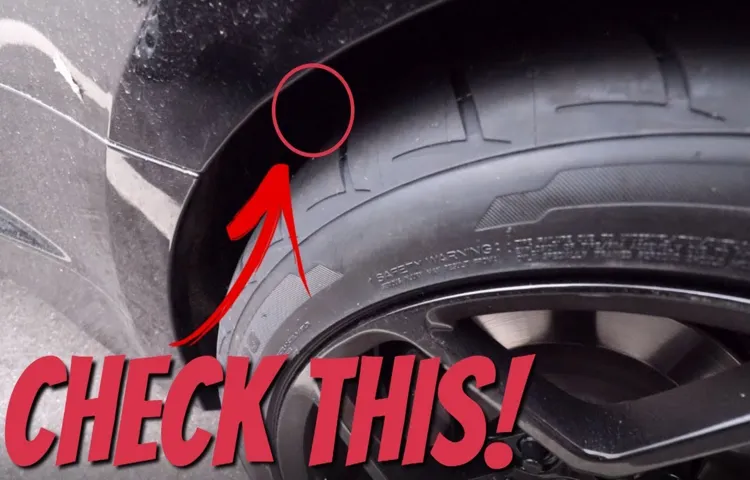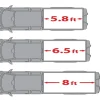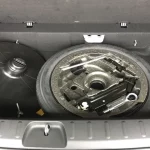Have you ever had a slanted back tire while driving? It can be a nerve-wracking experience, and if left untreated, it can lead to more significant problems down the road. A slanted back tire can impair your driving experience, causing discomfort, and compromise your safety on the road. There are many possible causes of a slanted back tire, such as misaligned wheels, worn-out components, and under-inflation.
The good news is that most of these issues are relatively easy to fix. In this blog, we will cover some of the possible causes and solutions for a slanted back tire, helping you identify the problem and resolve it before it becomes a bigger issue. Let’s dive in!
Table of Contents
Uneven Wear on the Tire Tread
Have you ever noticed that your back tire looks slanted or uneven? This can be a sign of uneven wear on the tire tread. There are several reasons why this can happen, including improper inflation, misalignment, and worn suspension components. When a tire is not properly inflated, it can cause the tire to wear more on one side than the other, creating a slanted appearance.
Misalignment can also cause uneven wear on the tire tread, as it puts more pressure on one side than the other. Worn suspension components can also contribute to uneven wear, causing the tire to tilt and wear more on one side. It is important to regularly check your tire pressure and have your alignment and suspension checked to ensure even wear on your tires and prolong their lifespan.
Checking the Tread Depth and Pressure
When checking your tire tread and pressure, it’s important to look out for signs of uneven wear. This can be caused by a variety of factors, such as misaligned wheels, over/under-inflation, and harsh driving conditions. Uneven wear can lead to reduced traction and handling, as well as increased risk of blowouts.
To prevent this, regularly inspect your tires for any signs of wear on the outside, center, or inner edges of the tread. If you notice any irregularities, it’s best to have your tires checked by a professional mechanic. Additionally, ensuring proper tire pressure can also prevent uneven wearing.
Remember to always use a tire pressure gauge to check the pressure when the tires are cool, and adjust accordingly to the manufacturer’s recommended levels. Proper maintenance of your tires can not only prevent safety hazards but also improve your vehicle’s overall performance.

Replacing the Tire if Necessary
If you notice uneven wear on the tread of your tire, it’s important to replace it as soon as possible. Uneven wear indicates a problem with the alignment or suspension of your vehicle, which can cause further damage to your tire or even lead to an accident. If you’re unsure whether your tire needs replacing, you can perform the penny test.
Simply insert a penny into the tread with Lincoln’s head facing down. If you can see the top of Lincoln’s head, your tread is too shallow, and you need to replace your tire. Remember that driving on a tire with shallow tread can be dangerous, as it reduces your tire’s ability to grip the road and increases the risk of hydroplaning on wet surfaces.
So, if you’re in doubt, it’s best to err on the side of caution and replace your tire immediately.
Misaligned Rear Suspension
If you’ve noticed that your back tire looks slanted, it could be due to a misaligned rear suspension. This can occur when the rear suspension is not adjusted properly, causing the tire to tilt inwards or outwards. It can also be caused by worn-out or damaged suspension components, such as bushings or shocks.
Misaligned rear suspension can also affect your vehicle’s handling and stability, compromising your safety on the road. It’s important to have a professional mechanic inspect and diagnose the issue, as this could be indicative of more serious problems with your suspension. Don’t ignore a slanted back tire, as it could lead to further damage and costly repairs down the line.
Inspecting the Suspension Components
When inspecting suspension components, it is important to keep an eye out for misaligned rear suspension. This can occur when there is damage or wear to the suspension parts that connect the wheels to the vehicle. A misaligned rear suspension can cause uneven tire wear, handling issues, and a rough ride.
It may also be accompanied by clunking sounds when going over bumps or uneven surfaces. If you suspect that your vehicle has a misaligned rear suspension, it is recommended to have it inspected and repaired by a professional mechanic as soon as possible. Ignoring the issue can lead to further damage or safety risks when driving on the road.
By addressing the issue early on, you can ensure a safer and smoother driving experience.
Adjusting or Replacing the Parts as Needed
If you’re experiencing a misaligned rear suspension, one of the first things to check is the control arm bushings. These connect the control arms to the frame of the car and can wear out over time, causing misalignment. If the bushings are worn out or cracked, they will need to be replaced.
Another part that can contribute to misalignment is the rear sway bar. This bar connects the rear wheels and helps stabilize the car during turns. If it is damaged or disconnected, it can cause the wheels to become misaligned.
Finally, the rear subframe can also be a culprit. This is the frame that holds the suspension in place and if it is rusted or damaged, it can throw off the alignment. It’s important to address misalignment issues as soon as possible, as they can lead to tire wear and poor handling.
Worn Wheel Bearings or Axle
If your back tire looks slanted, there’s a good chance that your wheel bearings or axle may be the culprit. Over time, these components can experience wear and tear, leading to uneven pressure on your tires. Worn wheel bearings can cause your tire to tilt inwards or outwards, while a bent or damaged axle can cause your tire to lean to one side.
Not only can this affect the handling and stability of your vehicle, but it can also cause uneven wear on your tire and shorten its lifespan. If you suspect your wheel bearings or axle may be the issue, it’s important to have a mechanic inspect your vehicle as soon as possible to prevent any further damage or safety risks. So, don’t hesitate to take your vehicle to a professional mechanic whenever you notice any unusual changes in your car’s handling or tire alignment.
Checking for Play or Noise in the Bearings
If you hear any play or noise in your vehicle’s bearings, it could be an indication of worn wheel bearings or axle. These components are essential for your vehicle’s safety and should be checked regularly to prevent any accidents. If you hear grinding or scraping sounds coming from your wheels, it could be a sign of damaged or worn bearings.
You can also check for play by trying to wiggle your wheels from side to side. If they move excessively, there is likely a problem with your bearings. Ignoring these warning signs can lead to serious consequences like loss of control while driving.
Therefore, it’s crucial to get your bearings and axle inspected and replaced as soon as possible to ensure your safety on the road. So, make sure to take your vehicle to a trusted mechanic if you hear any unusual sounds or notice any excessive play in your wheels.
Replacing the Bearings or Axle if Worn Out
If you’ve been experiencing unusual noises, vibrations, or poor handling, your vehicle’s wheel bearings or axle may be worn out and need replacement. Wheel bearings are an essential component of your car’s suspension system, while axles transmit power from the engine to the wheels. As such, both the bearings and the axle are under constant stress, making them susceptible to wear and tear over time.
When either of these components malfunctions, it can lead to significant issues such as wheel wobbling, difficulty steering, or even loss of control, putting you and other road users at risk. You can avoid this by having a qualified mechanic inspect your vehicle regularly for signs of wear and tear and replace any damaged bearings or axles promptly. By doing so, you’ll ensure that your car remains safe, reliable, and efficient on the road for years to come.
Incorrect Installation of the Tire
Have you ever looked at the back tire of your bike and noticed that it appears slanted? If so, there could be several possible reasons for this, but one of the most common is an incorrect installation of the tire. This could happen if the tire is not properly aligned with the rim, causing it to sit at an angle rather than straight up and down. Additionally, if the tire is not inflated to the correct pressure, it could also cause it to appear slanted.
It’s important to regularly check the alignment and inflation of your tires to ensure they are functioning properly and to prevent any potential safety hazards while riding. If you are not sure how to properly install and align your bike tires, it’s always best to consult a professional to avoid any mistakes that could lead to an accident.
Remounting and Balancing the Tire Correctly
Remounting and balancing your tire accurately is vital for the safety and longevity of your vehicle. If installed incorrectly, your tire could cause serious problems, such as vibrations, uneven wear, or even a blowout. Improper installation can occur during the tire replacement or due to a botched balancing job.
When it comes to remounting the tire, the tire technician must ensure proper alignment, torque, and bead seating. Additionally, the wheel must be adequately balanced to prevent uneven wear and wobbling. A poorly balanced wheel can not only cause shaking but also create unnecessary stress on your suspension system.
Therefore, it is essential to trust professionals to handle your tire installation to avoid the risk of potential dangers and costly repairs down the road. Remember, taking the extra minute to check and correct your tire installation can save you time and money in the long run.
Conclusion
Well, I hate to be the bearer of bad news, but it looks like your back tire is suffering from a severe case of attitude. That’s right, it’s got a major chip on its shoulder and is standing at a slight angle to show off its rebellious side. Just kidding! In all seriousness, the slanted look of your back tire could indicate a variety of issues such as low pressure, worn out suspension, or misaligned wheels.
So, let’s get that tire checked out before it starts spouting off to other tires about its cool new angle.”
FAQs
What could be the possible reasons for the back tire to look slanted?
There could be many reasons for a back tire to look slanted, such as poor alignment, worn-out suspension components, or low tire pressure.
How can I check the alignment of my back tire?
The simplest way to check the alignment of the back tire is by using a measuring tape to ensure that the distance between the center of the tire and the frame is equal on both sides.
Is it safe to drive with a slanted back tire?
No, it is not safe to drive with a slanted back tire as it can lead to poor vehicle handling and control, increased fuel consumption, and uneven tire wear.
What is the cost of fixing a slanted back tire?
The cost of fixing a slanted back tire depends on the extent of the damage and the type of repair needed. It can range from a simple alignment service to replacing the suspension components, which can be expensive.
Can I fix a slanted back tire myself?
It is not recommended to fix a slanted back tire yourself, as it requires expertise and specialized tools. Taking it to a professional mechanic is a better option to ensure proper repairs.
Is a slanted back tire a sign of a bigger problem with the vehicle?
Yes, a slanted back tire can be a symptom of a bigger problem with the vehicle, such as worn-out suspension components, which need to be inspected and repaired as soon as possible.
How often should I get my vehicle’s alignment checked?
It is recommended to get your vehicle’s alignment checked at least once a year or every 10,000 miles, whichever comes first, to ensure proper tire wear and vehicle handling.




